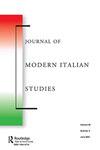The futures of post-displacement
IF 0.7
3区 历史学
Q1 HISTORY
引用次数: 0
Abstract
The rich set of articles collected here and edited by Emma Bond and Stavroula Pipyrou raise provocative questions about post-displacement generally and post-displacement futures in Italy specifically. In proposing the concept of post-displacement, Bond and Pipyrou highlight the deep and entangled histories of migration and colonialism that inform present day experiences of and contests over migration in Italy. At the same time, in their use of the prefix ‘post’, they shift attention to future oriented visions, hopes, potentialities, and anxieties. In particular, they focus on ‘the gaps, intervals, pauses and delays between hope and disillusionment that characterize displacement, because it is in this gap that speculation resides’. This move underscores the contingencies of historical processes and disrupts easy linear narratives, despite the ways that the ‘post’ tag conventionally stands for what comes after in a chronological sequence. In a now distant 1992, Anne McClintock cautioned scholars about the ‘almost ritualistic ubiquity of “post” words in current culture’, noting how the ‘term post-colonial . . . is haunted by the very figure of linear “development” that it sets out to dismantle’ (McClintock 1995, 10). As the articles reveal, the editors and authors reference multiple meanings and registers of ‘post’ displacement. To be sure, in some instances post here does signal something that follows another state or period, as with Giuliana Sanò and Francesco Zanotelli’s exploration of migrant experiences after their reception within the bureaucratic machinery of the Italian/E.U. mobility regimes. Yet Sanò and Zanotelli do not restrict their meaning to mere posteriority, exploring the multiple temporalities and spatialities (or im-mobilities, as opposed to mere immobilities) that characterize migrants’ experiences beyond institutional reception centres. This conjoins notions of after and beyond, time and space, as well as North and South, to reread the experiences of migrants like the young Malian man Djon interviewed by Sanò. Whereas in the eyes of anti-immigrant populists Djon might appear to be ‘doing nothing’ to improve his living conditions and opportunities, Sanò and Zanotelli consider Djon’s non-action as ‘a tactic . . . . . . the capability of Djon to practice his future while standing still’. This reminds us that waiting does not JOURNAL OF MODERN ITALIAN STUDIES 2023, VOL. 28, NO. 4, 495–502 https://doi.org/10.1080/1354571X.2023.2202975流离失所后的未来
Emma Bond和Stavroula Pipyrou在这里收集并编辑了一系列丰富的文章,这些文章对流离失所后的总体情况以及意大利流离失所后的未来提出了挑衅性的问题。在提出后流离失所的概念时,邦德和皮皮鲁强调了移民和殖民主义的深刻而纠缠的历史,这些历史为当今意大利移民的经历和竞争提供了信息。同时,在使用前缀“post”时,他们将注意力转移到面向未来的愿景、希望、潜力和焦虑上。特别是,他们关注的是“希望和幻灭之间的差距、间隔、停顿和延迟,这些都是流离失所的特征,因为正是在这种差距中存在着猜测”。这一举动突显了历史进程的偶然性,并颠覆了简单的线性叙事,尽管“后”标签通常代表按时间顺序排列的内容。在一个遥远的1992年,Anne McClintock提醒学者们注意“后”词汇在当前文化中几乎是仪式性的普遍存在”,并指出“后殖民主义。被它打算拆除的线性“发展”的数字所困扰(McClintock 1995,10)。正如文章所揭示的,编辑和作者引用了“后”位移的多种含义和寄存器。可以肯定的是,在某些情况下,这里的帖子确实预示着另一个国家或时期的到来,比如朱利安娜·圣奥和弗朗切斯科·扎诺泰利在意大利/欧盟流动制度的官僚机构中接受移民后对移民经历的探索。然而,Sanå和Zanotelli并没有将他们的意义局限于后验性,他们探索了移民在机构接待中心之外的经历所特有的多重时间性和空间性(或流动性,而不仅仅是不动性)。这结合了之后和超越、时间和空间以及北方和南方的概念,重读了像Sanå采访的马里年轻人Djon这样的移民的经历。在反移民民粹主义者眼中,Djon似乎对改善自己的生活条件和机会“无所作为”,而Sanå和Zanotelli则认为Djon的不作为是“一种策略……”。Djon在静止不动的情况下实践自己未来的能力。这提醒我们,等待并不是《现代意大利研究杂志》2023年第28卷第4期,495–502https://doi.org/10.1080/1354571X.2023.2202975
本文章由计算机程序翻译,如有差异,请以英文原文为准。
求助全文
约1分钟内获得全文
求助全文
来源期刊

Journal of Modern Italian Studies
Multiple-
CiteScore
1.00
自引率
25.00%
发文量
66
期刊介绍:
The Journal of Modern Italian Studies (JMIS) is the leading English language forum for debate and discussion on modern Italy. This peer-reviewed journal publishes five issues a year, each containing scholarly articles, book reviews and review essays relating to the political, economic, cultural, and social history of modern Italy from 1700 to the present. Many issues are thematically organized and the JMIS is especially committed to promoting the study of modern and contemporary Italy in international and comparative contexts. As well as specialists and researchers, the JMIS addresses teachers, educators and all those with an interest in contemporary Italy and its history.
 求助内容:
求助内容: 应助结果提醒方式:
应助结果提醒方式:


